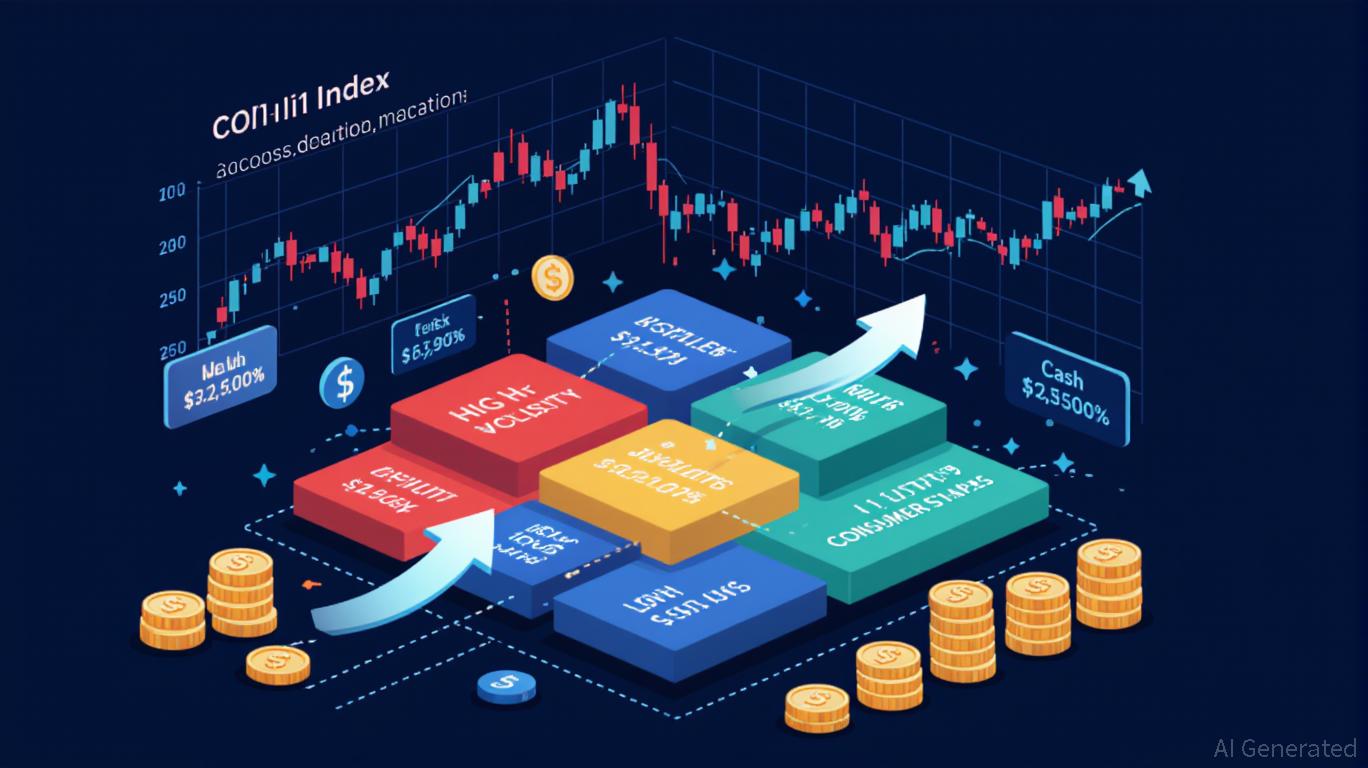The Unexpected COAI Price Decline: Key Lessons for Investors from the November 2025 Market Turbulence
- COAI Index's 88% November 2025 collapse stemmed from C3.ai governance failures, regulatory ambiguity, and panic-driven herd behavior. - Market psychology amplified losses as investors overreacted to AI sector risks, ignoring fundamentals and triggering liquidity crises. - Diversification, cash reserves, and AI-driven tools helped mitigate risks, emphasizing long-term strategies over speculative hype. - The crisis exposed dangers of overreliance on AI/DeFi narratives, urging disciplined, diversified portf
The COAI Index Crash: A Case Study in Market Fragility
In November 2025, the COAI Index experienced a dramatic decline, plummeting by 88% within a matter of weeks. This event starkly illustrated how quickly confidence can evaporate in speculative markets. The collapse was not just a routine correction; it was a systemic failure fueled by lapses in corporate governance, unclear regulatory guidance, and a wave of emotionally charged decisions by investors. This episode highlights the importance for investors to recognize the psychological dynamics at play during market upheavals and to employ disciplined, diversified approaches to safeguard their portfolios.
Key Triggers: Leadership Failures and Regulatory Confusion
The downfall of the COAI Index was set in motion by turmoil at C3.ai, a pivotal player in the AI and DeFi landscape. By early 2025, the company was already under pressure, having reported a $116.8 million deficit, undergone a contentious change in leadership, and faced a class-action lawsuit over alleged mismanagement. These issues severely undermined confidence in the company and, by extension, cast doubt on the broader promise of AI-powered crypto ventures. The situation was further complicated by the introduction of the CLARITY Act—a regulatory initiative intended to bring oversight to AI technologies. Instead of providing clarity, however, it left investors uncertain about compliance and potential liabilities, deepening the sense of instability.
Investor Behavior: Panic, Herd Mentality, and Biases
The crash of the COAI Index was as much about psychology as it was about economics. After months of volatility, investors responded with panic-driven selling, heavily influenced by herd behavior and cognitive distortions. According to a Bitget report, the market panic in April 2025, which was sparked by similar concerns in the AI sector, revealed that many investors fell prey to "recency bias"—overestimating the likelihood of ongoing gains while ignoring mounting risks. Social and traditional media amplified these anxieties, fueling a cycle of fear and further sell-offs. Deutsche Bank's AI-powered dbLumina system demonstrated that, during downturns, human investors often act irrationally, locking in losses and missing out on eventual recoveries.
This emotional response was evident as COAI investors continued to exit the market, even as the S&P 500 rebounded by 23% after the April 2025 low. Many mistook isolated corporate setbacks for systemic threats, triggering a liquidity crunch that intensified the decline.
Protective Measures: The Role of Diversification and Discipline

The COAI Index collapse underscored the necessity of robust risk management. Defensive tactics—such as shifting investments into traditionally stable sectors like utilities and consumer staples—became increasingly popular as investors sought to shield their capital. Fixed-income assets and cash holdings also served as important buffers against the volatility of the AI sector. Research from GetCOAI in 2025 found that maintaining a cash allocation of 20-30% enabled investors to seize opportunities in undervalued assets during the downturn.
For those with exposure to AI and DeFi, spreading investments across different regions and industries proved vital. Value and small-cap stocks, which often outperform during corrections in growth sectors, helped balance portfolios. Additionally, using options and derivatives—such as purchasing put options on broad market indices—offered protection against losses without sacrificing the potential for gains.
Long-Term Strategy: Steering Clear of Speculative Traps
The COAI Index crash also revealed the risks of chasing speculative trends. Many younger investors were drawn in by the promise of an "AI revolution," often at the expense of sound fundamentals. Those who maintained a long-term perspective and diversified their holdings weathered the storm more effectively. As highlighted by Investment News, investors who stuck to a balanced 60/40 mix of equities and fixed income experienced minimal capital loss during the crisis.
Importantly, the turmoil demonstrated the value of AI-based analytical tools in counteracting emotional decision-making. Systems like dbLumina, which assess market trends without human bias, provided more objective guidance during the downturn. This suggests that individual investors could benefit from incorporating algorithmic analysis into their investment strategies to help avoid panic-driven mistakes.
Takeaways: Building Resilience for Future Shocks
The events surrounding the COAI Index in November 2025 serve as a powerful lesson on the interconnected roles of governance, regulation, and investor psychology. While volatility is an inherent feature of speculative sectors like AI and DeFi, the scale of the collapse was magnified by herd behavior and insufficient risk management. The key message for investors is clear: diversify across sectors and asset types, maintain adequate liquidity, and focus on long-term fundamentals rather than short-lived trends. In a world where market disruptions are becoming more common, maintaining discipline and strategic foresight is essential for enduring success.
Disclaimer: The content of this article solely reflects the author's opinion and does not represent the platform in any capacity. This article is not intended to serve as a reference for making investment decisions.
You may also like
Ethereum News Update: Avail’s Nexus Bridges Liquidity Across 12 Blockchains, Tackling Fragmentation
- Avail's Nexus Mainnet launches as a cross-chain execution layer unifying liquidity across 12 blockchains including Ethereum and BNB Chain. - The intent-solver architecture automates optimal routing while aggregating liquidity from multiple chains through Avail's data availability layer. - Developers gain simplified cross-chain integration via SDKs and APIs, enabling real-time collateral pools and intent-based trading without managing bridges. - With Solana integration planned and Infinity Blocks roadmap

Ethereum News Update: Ethereum Drives Institutional Transformation with Amundi Tokenizing Major Fund
- Amundi tokenizes a money market fund on Ethereum , signaling institutional adoption of blockchain-based asset management. - Ethereum's upgrades like PeerDAS and Bhutan's $970k ETH staking highlight growing institutional trust in its infrastructure. - CoinShares' $250M Bitcoin Miners ETF and global digital ID initiatives underscore tokenization's role in modernizing finance. - Ethereum's $3,100 price resistance and technical indicators suggest potential for long-term resilience amid scaling improvements.

Hyperliquid News Today: Hyperliquid Adopts Tidewater’s Strategy to Streamline Crypto Risk Management
- Hyperliquid introduces automated downsizing to stabilize HYPE, which dropped 52% from its peak. - Strategy mirrors Tidewater Renewables' capacity management, balancing short-term volatility with long-term stability. - Hyperliquid Strategies DAT plans $300M HYPE buybacks to inject liquidity and institutional-grade risk frameworks. - Market faces $1.89B+ liquidation risks if Bitcoin/Ethereum surge, prompting automated buffers to prevent cascading sell-offs. - Approach reflects growing DeFi adoption of algo
CME Suspension: Global Market Vulnerabilities Revealed by Thermodynamic Constraints
- CME Group halted Globex trading on Nov 28, 2025 due to CyrusOne cooling system failure in Chicago, freezing 90% of global derivatives markets. - The outage caused erratic price swings in gold/silver and disrupted EBS forex platforms, exposing vulnerabilities in third-party data center reliance. - Despite post-holiday timing softening immediate impact, the incident highlighted systemic risks from thermodynamic limits in AI-era infrastructure. - CME faces pressure to build redundant systems as it expands c
